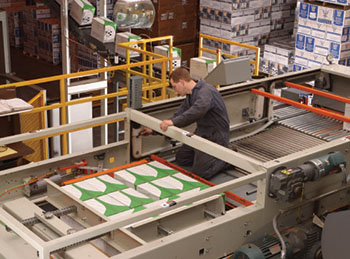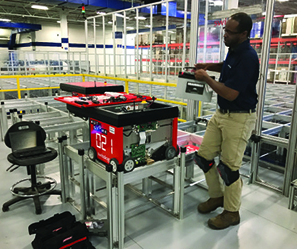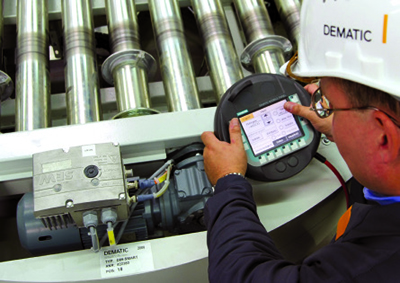Best Practices: Preventative Maintenance 101
Why a proactive, calculated approach works best when it comes to maintaining and prolonging the useful life of warehouse automation equipment, and five ways to get on the right track now.
When Fritz Page became HEB Grocery Company’s maintenance manager two years ago, he immediately embraced his new role as head of maintenance for a fully automated warehouse. Based in San Antonio, Texas, the privately held supermarket chain he works for relies on seven different complexes, each of which has its own warehouses and/or self-manufacturing facilities. Most of those locations are “standard,” by nature, according to Page, but the San Marcos facility he’s responsible for includes a full range of cranes, conveyors, palletizers, sorters and other equipment.
“When I got here, it was evident that a lot of the preventative maintenance (PM) programs in place were based on the OEM’s recommendations,” says Page, who has been with HEB for 22 years. “And while these plans were effective, in many cases the PMs were basically just copied from ‘the book’ on what should be done, so that’s what the mechanics did—and without conducting a really thorough analysis of what the equipment really needs to be able to run in tip-top shape.”
Page says he saw the opportunity to take a more proactive approach to maintenance. “A lot of maintenance-related books discuss PMs as the foundation of a maintenance system,” says Page, “but in many cases that philosophy is based on building a foundation and then forgetting about it. I knew there were some areas of improvement to explore.”
Likening preventative maintenance to the hull of a ship, Page says he prefers to focus on “keeping the ship moving without sinking it” by adding too many PMs to the equation. From there, he and his team keep a sharp eye out for potential “leaks” and then use preventative maintenance tactics to keep the ship afloat. “It’s a constant process for us as we look at the PMs and monitor exactly what’s happening with the equipment,” says Page.
Take cleaning, for example. Page says his facility has been paying more attention to this important maintenance component over the last 12 months because maintenance workers tend to avoid the chore. “In order for us to see how the equipment is performing, the area around it has to be clean,” says Page, who has enlisted the facilities’ operations and sanitation teams in the initiative.
“In many cases, the only way to see what’s leaking—and then catching it early—is if you have a clean floor below the actual equipment,” he points out. “Otherwise it just gets muddied up in whatever else is on the floor.” Ultimately, Page says preventative maintenance falls on the shoulders of everyone who comes into contact with the machines and/or the facility on a daily basis. And it’s something that can’t be done once a year; it has to be conducted on a regular, ongoing basis. “It’s a constant process of having everyone ‘own’ the success of the equipment and the operation as a whole, with basic cleaning behind the cornerstone for this effort,” says Page.
Page says regular and seemingly innocuous equipment outages are another area that he pays attention to, and namely because these little “blips” frequently foreshadow a more serious problem. “When there are interruptions of just a few minutes here or there, employees don’t always recognize them or even notice them,” says Page. “In reality, when you start to log these occurrences, see how frequently they’re happening, and how they’re impacting operations, the time starts to add up.” 
The proactive approach
You wouldn’t wait until your vehicle was out of gas to fill the tank, depleted of oil to put more in, or running on tread-less tires before making an investment in this important piece of machinery, so why would you wait until your warehouse equipment was broken down and inoperable to repair it? Unfortunately, this is exactly the tack that many companies take after investing in equipment that they either assume is going to run forever or miraculously fix itself.
“Many companies wait for an emergent event or breaking point versus conducting preventative maintenance upfront,” says Royden Edwards, director of CS services for Swisslog. “There’s an assumption that this is somehow cheaper because preventative maintenance requires more frequent parts replacement, and companies will try to do things like get another month out of their existing parts.” 
Other companies simply avoid the shutdowns required to actually conduct the preventative maintenance in the interest of keeping their operations up and running 24/7/365. Most companies that fall into this category opt for once-a-year maintenance reviews and/or scheduled shutdowns during the summer or holidays. Unfortunately, eking maximum life out of consumable parts can quickly backfire on the company that relies on its automated machinery to keep its operations going.
Within the operations and distribution sector, for example, Edwards says “unplanned events are generally always more expensive than regular, preventative maintenance.”
Five PM best practices to follow, companies that want to do a better job of monitoring, maintaining and cleaning their warehouse automation equipment can start by following these five best practices:
- Have a clear vision of your assets, goals and procedures. Rather than taking a random approach to preventative maintenance, put some time and effort into identifying your company’s assets. Then, come up with a clear set of goals and the processes and procedures required to achieve those goals. “Look at what maintenance steps need to be performed and on what type of schedule,” says David Trice, Intelligrated’s senior director of business development—LSS. “Then, put a plan together based on this information and on your supplier’s recommendations.”
- Use technology to your advantage. Where maintenance managers once waited for an oil leak, grinding sound or unusual activity to signal a problem, technology has stepped up to the plate to help. Using a computerized maintenance management system (CMMS), companies can maintain a computer database of information about their maintenance operations and even give access to that information to their equipment vendors. CMMS solutions also help companies stay accountable, avoid costly errors and establish key maintenance metrics for their equipment. “We highly recommend that our customers use a CMMS that allows us to make modifications and adjustments over time,” says Todd Sermersheim, vice president of customer service at Dematic. “It’s about following a very regimented process of ensuring that both predictive and preventative maintenance is done on time and with a specific process.”
- Lean on your vendors for help. Your OEMs are often the best source of materials, assistance and software related to preventative maintenance programs. “Go to the suppliers of the equipment in your facility and ask them for their preventative maintenance specifications; everyone has that information,” says Edwards. “As suppliers, we’re not only selling those types of programs, so we’re also willing to share guidelines, processes and other important information with our customers.”
- Gather equipment downtime data. As Page pointed out, preventative maintenance is as much about identifying major problem areas as it is about paying attention to even the smallest of failures as they occur. According to Sermersheim, companies should focus on collecting as much data about these issues, and also about the amount of time it takes for personnel to respond to such issues and how long it takes for them to get the equipment back up and running. “When you can drill down to the mean time to repair and the mean time between failures,” says Sermersheim, “you can begin to focus on the issues that are creating the biggest impact on your operations.”
- Become less “reactionary.” The changeover from conducting random, remedial repairs to orchestrating preventative maintenance will require a major cultural shift for some companies, but the transition will be well worth it. “It’s challenging because you’re no longer reacting to something that’s gone wrong. You didn’t hear a noise or feel a shudder,” says Trice. “Instead, you’re trying to get ahead of these issues.” To achieve that goal, he says, the “it’s running fine because it’s not making any noises” mindset must be replaced with one that says, “just because we don’t physically see the wear and tear, that doesn’t mean we can’t take the right preventative steps to make sure it doesn’t occur.”
Avoiding “unplanned” downtime
Taking a preventative stance to equipment maintenance helps create cost and time savings that can’t be realized by simply using remedial maintenance procedures. “When you only do remedial maintenance, you’re just fixing equipment that’s been damaged,” says Sermersheim, “and taking the spotlight off the tune-ups, adjustments, lubrication and other steps that keep your equipment running in the most optimal possible manner.”
Preventative maintenance also helps companies save the life of their assets and reduce unplanned downtime, Trice says. “Eventually, the asset will fail for a reason that could have been solved proactively during planned downtime,” says Trice. “If you don’t have that preventative maintenance worked into your schedule, you can be sure that downtime will come at the worst possible time.”













